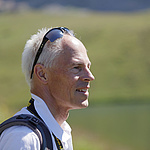Ken Andersen's testimony
The testimony of Ken Andersen, ILL Director
Original text in English
Traduction en Français ici.
Dear colleagues, dear friends, dear family of Björn,
The sudden and unexpected way in which Björn died has left many of us in somewhat of a state of shock. This ceremony is an important part of the grieving process for those that he leaves behind – an occasion dedicated to him, in which we can come together to share thoughts and feelings, both spoken and unsaid, about our dear friend and colleague. It is also an occasion for us to celebrate his life, his career, his accomplishments, and the impact he had on us.
Björn studied at the KTH in Stockholm and the Technical University in Linköping in Sweden. He got into neutron scattering at an early stage, working with Kurt Sköld at Uppsala University, and working at the Studsvik research reactor where he rebuilt a TOF spectrometer as a student. The main part of his PhD work centred around measuring excitations in liquid 3He and 3He/4He mixtures. Those of us who work with neutrons know 3He as the thing you use to absorb neutrons. As you might expect, it is one of the most difficult measurements you could do with neutrons. At ILL, we had just built a new instrument IN6 which was specifically designed in order to measure such difficult systems, and Björn worked closely with Reinhard Scherm who had designed IN6, as well as with colleagues of his at the PTB in Braunschweig. It was a landmark experiment, and one which succeeded in measuring, for the first time, the elementary excitations in this model quantum liquid.
I joined ILL as a PhD student shortly after Björn had finished his measurements, but while he was still working on his thesis. I studied the much easier system: liquid 4He – the non-absorbing variety – piece of cake in comparison. Björn agreed to be my local supervisor and did a fantastic job. He was the one I went to for help in understanding the basics. What is a Debye-Waller factor? What is a Jacobian? How does time-of-flight work? He was patient and pedagogical every time.
He told me he didn’t do particularly well in school. That really surprised me. I assumed someone as clearly gifted as he was would have been appreciated and encouraged by his teachers. But not everyone is as lucky as I was in having good mentors.
Towards the end, as I was working on finishing my thesis, he read through countless draft versions, patiently giving advice on improvements. This part needed more work. This statement needed to be backed up with evidence. But also: This was what I was good at. This was what I wasn’t so good at. He was honest, and he was also kind and constructive in giving criticism.
During that time, he was on a 5-year contract at ILL, first on IN8, then on IN12, and worked on instrument projects commissioning polarized neutrons on IN14 and designing and building the spin-echo option TASSE on IN20. Björn was a hands-on scientist, and he saw instrumentation development as an integral part of a scientist’s job.
When ILL shut down to replace its reactor vessel in 1991, Björn moved to the CEA Grenoble, working in the group of Jacques Flouquet, where he stayed for more than 20 years. He did many different things in that position including working as the CRG responsible for IN12 for 5 years and spending 3 years at ISIS on PRISMA and MARI.
He returned to ILL employment in 2014 to work on IN4C with Stéphane Rols and Olivier Meulien. He led the PANTHER upgrade project of IN4C together with Giuliana Manzin until its successful conclusion in 2022.
Björn’s work was a huge part of his life and his character.
He was passionate about his work, and I suspect more broadly than that, also about the endeavour of science in general. We were doing this because it was the right thing to do. We had a moral imperative to progress understanding and defend our right to uncover and speak the truth. He had no patience with incompetents or sloppy work. He pursued excellence and pushed himself and his colleagues to achieve high standards. He did so because it was the right thing to do, but he also did it with a smile and a glint in his eye. He knew you were on his side, as long as you put in the work!
Björn was a brilliant mentor to a long line of students and other early-career scientists. I like to think that he experimented with me. He was a great experimentalist. He was also an amazing local contact, making sure that no stone was left unturned in making each experiment a success. The scientists I have spoken to who had him as their local contact were unanimous in their praise. He would get it done. He was on your side. He would do the right thing.
Björn, you leave a big gap for us. You will be sorely missed.
Ken Andersen, Grenoble, 19/8/2024

